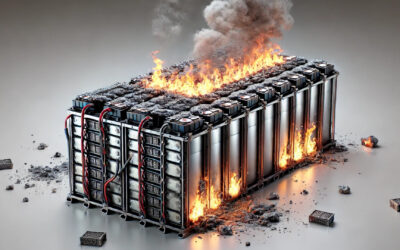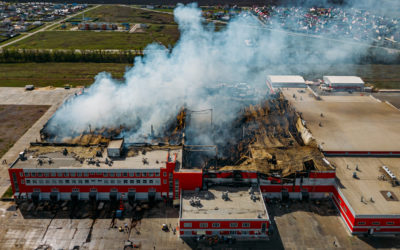Cobra used in attic and roof space fires.
Fires in attics and roof spaces pose significant risks to firefighters, with challenges such as limited access, unstable floors, potential roof collapse, high temperatures, and the added hazard of working at height.
Attics in apartment buildings are often used for storage, leading to a high fire load in these confined spaces. A fire starting in an attic can escalate rapidly, requiring a significant response from fire and rescue services. These fires can cause extensive damage to the building and lead to high costs if not contained swiftly.
Effective fire response in confined spaces
A crucial step in fighting fires in challenging spaces like attics is preventing the fire from spreading into other areas and causing further damage. This is typically done with internal firefighting and breathing apparatus (BA) attack.
However, by using the Cobra from outside the attic or roof space, such as from an aerial appliance or ladder, fire crews can efficiently control the fire and reduce smoke and heat in confined fires. This allows BA crews to enter and extinguish any remaining fire under significantly cooler and safer conditions.
Optimising communication and positioning
Clear communication is essential in these scenarios. The Cobra operator may be unable to see the effect Cobra is having on the fire, making close coordination with the crew and Incident Commander crucial to position the Cobra lance for maximum impact. Knowledge of building construction further enhances the ability to apply Cobra effectively for rapid fire control in confined spaces.
Cobra Benefits
Limits firefighter contamination from toxic fire gases.
The fire and fire gases are suppressed from outside the fire compartment with firefighters only entering to dampen the remaining hot spots. This limits exposure to toxic fire gases in a confined space such as an attic. If an opening can be created, then PPV can be used as the fire crews enter. This will reduce contamination as the fire gases are ventilated.
Minimises firefighter exposure to high temperatures.
Attic/roof space fires can expose firefighters to very high temperatures when attacking using traditional methods. Cobra utilises small water droplets, which are optimised at 0.1mm. These droplets absorb significant amounts of heat energy very quickly. This reduces the temperature within the fire compartment, allowing firefighters to enter a much cooler environment with a significantly reduced risk of backdraft or flashover.
Quick intervention.
Getting equipment in place to fight a fire in an attic or roof space can use up valuable time. Utilising Cobra from an aerial appliance, or from an adjacent compartment, reduces the amount of time taken to get water into the fire compartment. The equipment is light in weight and easy to handle, which enables rapid deployment. The training programme that underpins Cobra gives fire crews the ability and confidence to deploy Cobra very quickly on arrival.
Limits damage from fire and water.
Using traditional firefighting methods when fighting fires in attics/roof spaces uses a considerable amount of water – 450 litres per min or more. This will result in significant water damage to the rest of the property. Cobra uses 60 litres of water per minute – considerably less than traditional firefighting methods. A fine water mist used into a hot compartment will result in evaporation of the water and very little or no water damage.
Limits water use.
As Cobra only uses 60 litres of water per minute, an 1800 litre tank of water will last 30 minutes with continuous Cobra use. This gives fire crews an opportunity to secure further water supplies where needed – vitally important in areas where water supplies are scarce.
Reduces environmental impact from the fire.
The rapid fire and fire gas suppression associated with Cobra means that less toxic emissions get into the atmosphere. Reduced water consumption means less contaminated water runoff gets into watercourses.
Benefits of Cobra use
- Limits firefighter contamination from toxic fire gases
- Minimises firefighter exposure to high and very high temperatures
- Quick intervention
- Limits damage from fire and water
- Limits water use
- Reduces environmental impact from the fire
Source: Johansson, N., & Van Hees, P. (2010). A study of attic fire with the uses of statistics and fire investigations. (LUTVDG/TVBB—3152—SE; Vol. 3152). Department of Fire Safety Engineering and Systems Safety, Lund University.


